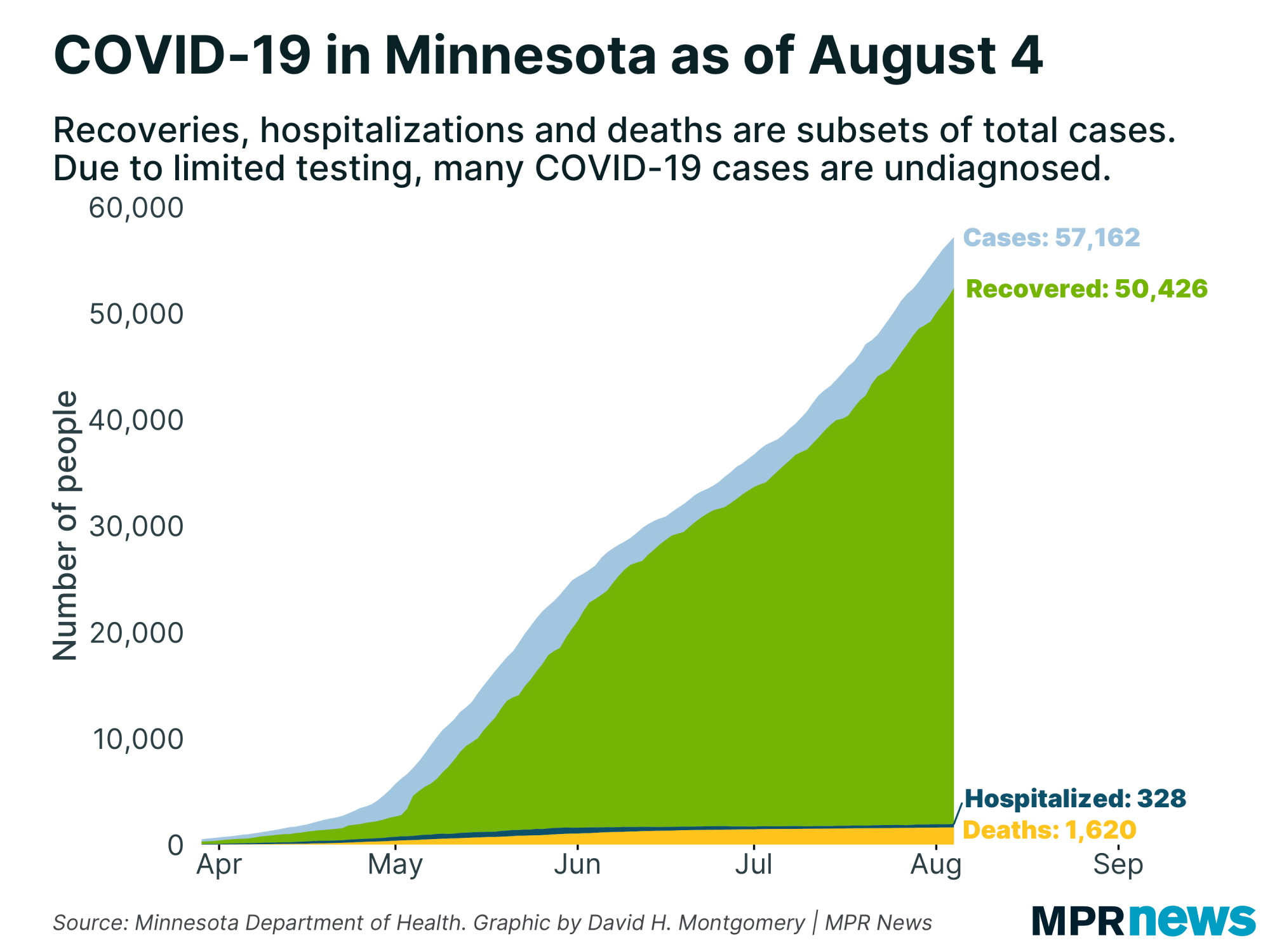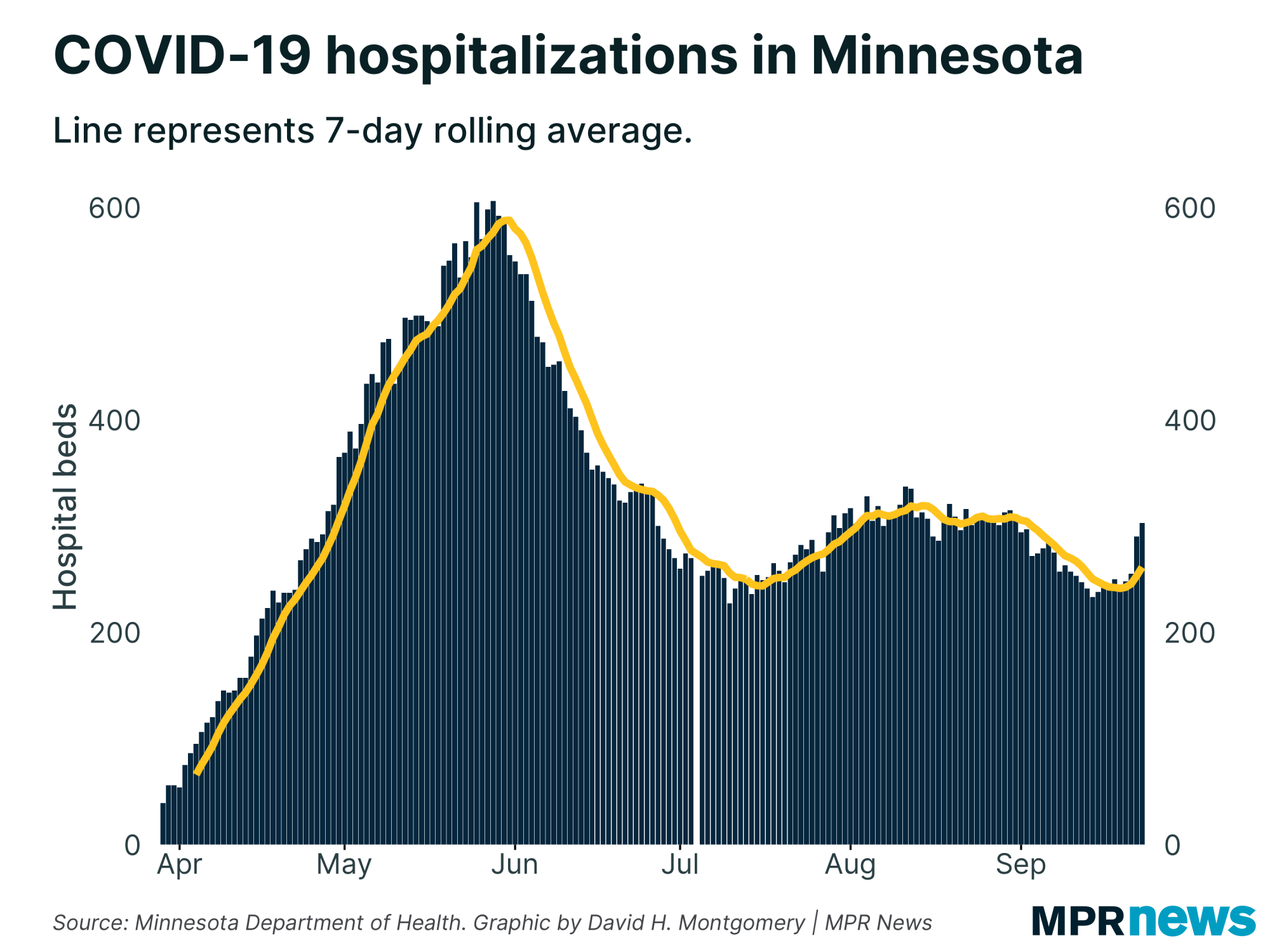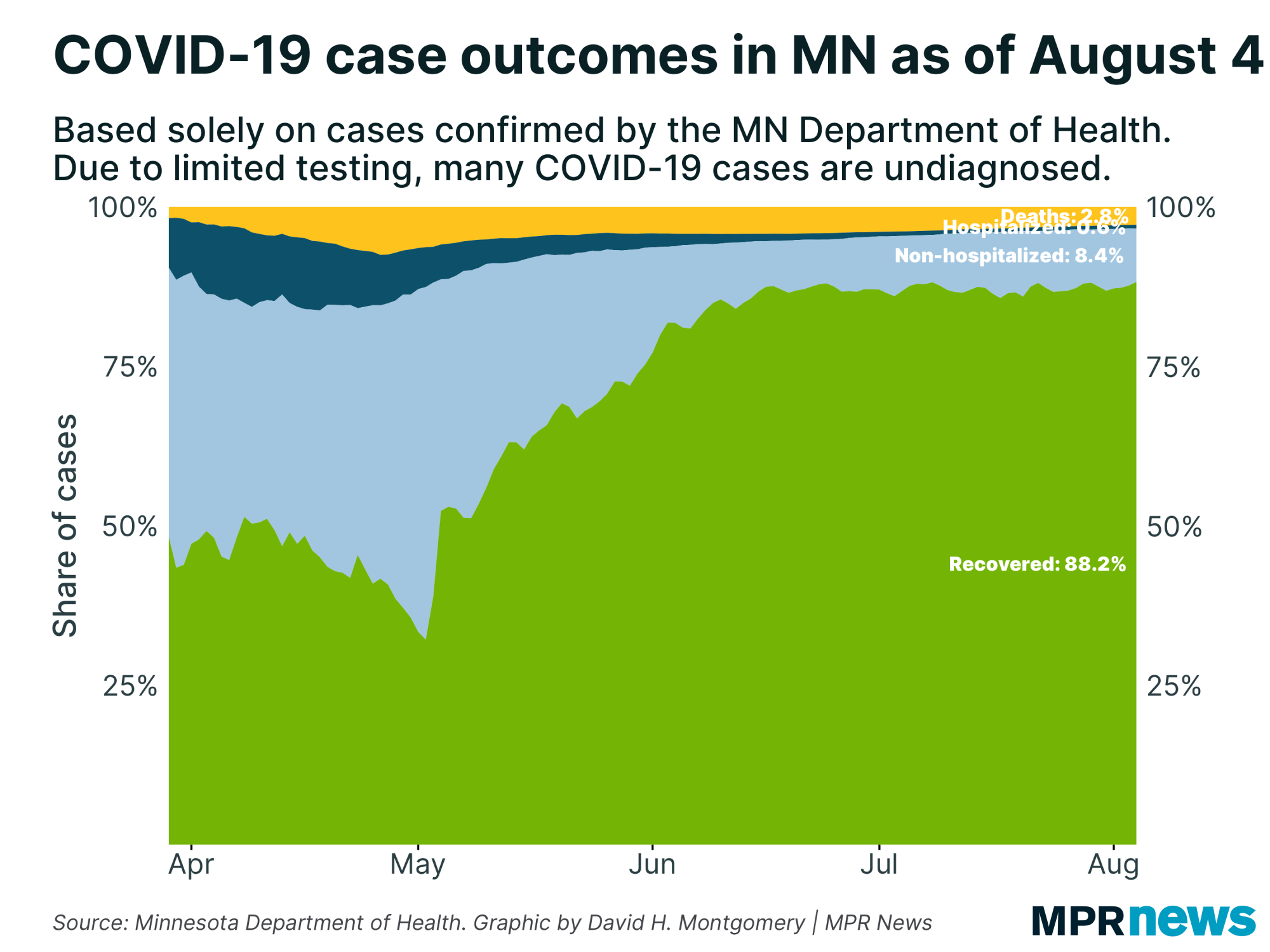July 30 update on COVID-19 in MN: 745 new cases, 5 more deaths; Walz unveils schools plan

Go Deeper.
Create an account or log in to save stories.
Like this?
Thanks for liking this story! We have added it to a list of your favorite stories.
Updated: 3 p.m.
As state leaders announced Thursday what they’re calling a localized, data-driven plan for returning to school in the fall, Minnesota’s COVID-19 data offered a familiar refrain. Cases continue to trend upward, partially explained by slowly rising testing volume. Hospitalizations are slowly trending upward. Deaths are flat.
The state Health Department reported 745 new confirmed cases Thursday, with 298 people currently hospitalized for the disease and 141 of those needing intensive care.
Hospitalizations and ICU cases — two closely watched metrics — dipped slightly from Wednesday. Still, officials are increasingly concerned about the overall direction of those numbers as new case counts rise.
The state also passed a milestone Thursday, reporting more than 1 million tests for the disease completed on 820,817 Minnesotans since the pandemic began.
Turn Up Your Support
MPR News helps you turn down the noise and build shared understanding. Turn up your support for this public resource and keep trusted journalism accessible to all.

Five more people have died from the disease, bringing the toll to 1,594 since the pandemic began. About 76 percent of those who’ve died had been living in long-term care or assisted living facilities, nearly all had underlying health problems.
Of the 53,692 confirmed COVID-19 cases during the pandemic, about 88 percent of those infected have recovered to the point they no longer need to be isolated.
More than a ‘blip’
The newest numbers came ahead of Gov. Tim Walz’s announcement Thursday on his decision about how to handle public school this fall, given the ongoing pandemic.
All this week, public health leaders have been ratcheting up their concerns that Minnesota is back on the wrong path in its fight against COVID-19’s spread.

With every decision Minnesotans make now about masking or not masking, socially distancing or not, “you are contributing to the solution, or to the crisis,” said Kris Ehresmann, the state’s infectious disease director.
Wednesday marked the first time in a month that total current hospitalizations rose above 300, the product of a weekslong upswing in new confirmed infections, coming a day after Minnesota saw one of its largest one-day increases in hospitalizations since the pandemic began.
While hospitalizations still remain far lower now than at the late-May peak, officials have been bracing Minnesotans in recent days to expect a surge following the climb in new confirmed cases.

“As we have feared, we are seeing our hospitalizations begin to increase, and I don’t think it’s just a blip,” Ehresmann said.
She also noted 83 new cases in long-term care facilities, a jump from the prior day — but most of the new infections were found in health care workers at those facilities, not residents. That’s especially worrisome because it indicates people are bringing in the disease and exposing vulnerable people.
Cases growing across age brackets, up north
State health officials continue to worry about the recent spike of coronavirus cases in younger Minnesotans, including that those infected will inadvertently spread the virus to grandparents and other more vulnerable populations.
Minnesotans in their 20s now make up the age group with the most confirmed cases in the pandemic, with more than 12,500. The median age of Minnesotans infected has been trending down in recent weeks and is now 36 years old.

Investigators continue to see rising cases with bars and restaurants at their center and are examining outbreaks in 28 establishments, Ehresmann said.
“Consider all the roles you play” in all daily interactions, she cautioned, noting that people who might not worry about themselves should worry about infecting vulnerable family members and coworkers.
Regionally, newly reported cases have been driven recently by the Twin Cities and its suburbs, but it’s present in all parts of the state, including the north, which had largely avoided the outbreak until recently.

Cases in Beltrami County, home to Bemidji, have more than doubled in the past week and a half, from 53 to 122 on Friday. That jumped again to 180 as of Thursday.
Ehresmann last week said the Beltrami case increase is tied to spread from athletic events and other public gatherings.
The six Minnesota counties with the fastest-growing COVID-19 case numbers over the last few days are in the northern and central parts of the state:

Walz school plan focuses on local, data
Walz announced a plan Thursday for what the school year will look like this fall, calling for school leaders to make staff and student health their top priorities. He urged them do the best they can to keep kids in school buildings when classes resume this fall.
The statewide plan calls for returning to in-person classroom teaching when possible, but leaving it to districts to decide whether their school systems will start the year in buildings, online or some combination — based on their local COVID-19 conditions.
The state Education Department for weeks has told school leaders to prepare for anything, including some combination of in-school and online instruction.
“Nobody wants kids in school more than me,” and state officials have been working for months on how to do that safely, Walz, a former high school teacher, said recently.
“We’re doing everything possible to get those kids back in those classrooms … to keep them there but also have some nimbleness” to move back to an online or hybrid model if cases start to climb, he said, adding: “This is gonna be a challenge.”

On Tuesday night, Minneapolis Public Schools said it plans to start out the school year virtually. Officials say they’ll create a better distance learning experience for families than during the time schools closed buildings last spring, and that the decision on when to return to school will depend on how COVID-19 evolves.
Separately on Wednesday, Walz announced plans to give away 4 million masks to businesses across the state for free to help comply with the mask mandate.
Walz and Minnesota health officials say the state needs 90 percent or better compliance to curb the spread of the virus and eliminate the need to walk back business openings.
Minnesota’s mask mandate took effect Saturday. State health officials said it would be several weeks before officials could assess its impact.
Developments from around the state
U of M plans to test students for COVID-19 on its five campuses
The University of Minnesota rolled out a COVID-19 testing plan for students for the fall semester across five campuses.
The plan calls for testing of people with COVID-19-related symptoms and close contacts who had exposure to a confirmed case. The testing also will cover asymptomatic individuals linked to an ongoing Minnesota Department of Health investigation and asymptomatic people who need specific medical care.
The head of the school's Health Emergency Response office, Jill DeBoer, said this is part of a multilayered approach to COVID-19.
"One of our important layers — and I feel that it's one of the most important layers — is to make sure that people at increased risk for complications from a COVID infection are supported to make individual decision about in-person work and in-person school," DeBoer said.
Among the other plans, the university will care and support students who live in campus residence halls who need to quarantine or isolate.
Earlier this week, the U of M announced that a majority of its classes this fall would likely be fully online due to the pandemic. More than 6,200 classes are listed as online or remote, but these numbers are not final, a spokesperson for the university said. Students are free to adjust their classes to take them in the format that works best for them.
— Peter Cox | MPR News
Como Zoo reopens — with some COVID-19 restrictions
St. Paul’s Como Zoo reopened on Wednesday after being closed to visitors for months because of the coronavirus.
The zoo is allowing up to 250 people at a time, with reserved entry at half-hour intervals. All staff and visitors are required to wear face masks. Reservations are limited to four people at a time. Visitors will move through the conservatory and zoo on a one-way walking path, although some buildings will be closed and the zoo will only be open from 10 a.m. to 4 p.m.
Como Zoo is the most recent major Twin Cities attraction to reopen. The Minnesota Zoo opened last week, and the Walker Art Center, the Bell Museum and the Minneapolis Institute of Arts opened earlier this month. The Minnesota Children's Museum will reopen Aug. 1 and the Science Museum of Minnesota is scheduled to reopen the first week of September.
— Tim Nelson | MPR News
Top headlines
Minnesota officials to announce fall school plans Thursday: Gov. Tim Walz has said his administration will give districts and charters guidance and then let them decide how best to implement it. The governor said he wants students to be able to return to in-person classes, but to do it safely. Meanwhile, district leaders say they’re hungering for specifics.
Minneapolis students likely to start year remotely: Minneapolis Public School officials plan to resume full-time remote learning this fall, though they’ll wait for the governor’s announcement Thursday to finalize the plan. Officials plan to improve the distance learning experience, even as they intend to bring students back to buildings later in the school year.
Mpls. limits bar service as people crowd too close together in some establishments: With COVID-19 cases on the rise in Minneapolis, Mayor Jacob Frey is imposing new restrictions on bars. The emergency order takes effect Saturday evening. It does not close the establishments entirely, but they’ll be table service only. Patrons will no longer be able to sit at the counter.
Higher COVID-19 rates seen in Black and Hispanic children in Minn.: Children’s Minnesota has treated around 300 pediatric COVID-19 cases as of mid-July. Thirty-one percent of those patients were Black or African American; 24 percent Hispanic; 16 percent white; and 11 percent Asian.
COVID-19 in Minnesota
Data in these graphs are based off Minnesota Department of Health cumulative totals released at 11 a.m. daily. You can find more detailed statistics on COVID-19 at the Health Department website.
The coronavirus is transmitted through respiratory droplets, coughs and sneezes, similar to the way the flu can spread.


